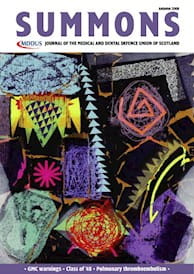THERE are certain conditions that prompt urgent investigation as soon as they enter the differential diagnosis. Pulmonary thromboembolism (PTE) is amongst the most important, with an in-hospital mortality rate of 6-15% and a high proportion of early deaths. Yet PTE is often missed, and frequently poorly managed. If PTE is suspected in primary care then the patient should be rapidly sent to the nearest secondary care service for diagnosis and appropriate treatment.
The annual incidence of PTE is 60-70 cases/100 000 and increases with age. In half of these cases it is the primary complaint, the remainder occurring whilst the patient is in residential care for another reason. Overall, three-quarters of patients will have a recognised predisposing factor (see list below).
This article will focus on suspected PTE and only deal with deep venous thrombosis (DVT) where relevant, though they are part of the spectrum of venous thromboembolism (VTE). The European Society of Cardiology (ESC) is publishing its new PTE guidelines in September 2008. The Scottish Intercollegiate Guidelines Network (SIGN; www.sign.ac.uk) are to publish their updated guideline in 2009/10.
Investigation
There are many ways in which a PTE may present, ranging from dyspnoea and/or pleuritic chest pain to haemodynamic collapse. History and examination are unreliable, particularly in excluding the diagnosis of PTE, and it is always wise to assess these patients in person rather than over the phone.
Defining individual risk is fundamental. A patient is high risk if they have clinical features of PTE, a major risk factor and absence of a reasonable alternative explanation. Tables to define individual risk, such as the Revised Geneva and Wells scores, are well established but should be used more often.
Suspected high-risk and non-high-risk PTE are two distinct situations with different diagnostic strategies. Indeed, the likelihood of death from non-massive PTE is small. But the chances of dying from massive PTE are substantial, and failure to diagnose or treat appropriately leaves the medical practitioner open to accusations of poor clinical care.
A negative plasma D-dimer result (<500 μg/l) coupled with low or intermediate clinical probability does not require further investigation, with a 3- month thromboembolic risk in patients left untreated below 1%. The crucial investigations in modern management are markers of myocardial injury, either troponin I or T, or brain natriuretic peptide (BNP). These markers of injury as well as concomitant assessment of markers of RV dysfunction, by echo, help to better sub-stratify patients with acute PE.
A chest X-ray is often taken, but is normal in PTE, unless there is other pathology present. In most centres, CT pulmonary angiography (CTPA) is the best test in patients with an elevated D-dimer level and the first-line test in patients with a high clinical probability.
Isotope scanning (the V/Q scan) is used for detection of segmental lung ventilation-perfusion mismatches and has been in use for many years. However, it only reliably diagnoses or excludes PTE in a minority of patients due to the high frequency of non-diagnostic or ‘intermediate probability’ scans. Crucially, V/Q scans are unavailable out of office cannot be performed in the critically ill. If the suspicion of massive PTE is high, an urgent CTPA should be performed.
Compression ultrasonography (CUS) to identify thrombus in lower limb veins is a difficult technique and should be reserved for patients in whom a CT is contraindicated (irradiation, renal failure, allergy to iodine contrast dye).
Acute treatment
All patients will require respiratory support in the form of supplemental oxygen with ventilation as a back-up. Immediate definitive treatment is determined by cardiovascular stability.
Haemodynamically unstable. This is an emergency situation and the clinical probability of PTE is usually high. Shocked patients need haemodynamic support with fluids or inotropes and specific treatment strategies which include thrombolysis, surgical embolectomy or catheter disruption. Simply administering subcutaneous heparin and hoping for the best is poor medicine and this practice must be abandoned.
Thrombolytic therapy rapidly resolves thromboembolic obstruction and exerts beneficial effects on haemodynamic parameters so should be administered to patients with high-risk PE, unless there are absolute contraindications to its use, such as active internal bleeding and recent spontaneous intracranial bleeding. Currently the best agent is recombinant tissue plasminogen activator (rtPA) but urokinase or streptokinase can be used if rtPA is unavailable. Like thrombolysis for acute MI, the risk of haemorrhagic stroke is low in younger patients but much higher among the elderly.
In patients with absolute contraindications to thrombolysis, or those in whom thrombolysis has failed to improve haemodynamic status, surgical embolectomy or percutaneous catheter embolectomy or thrombus fragmentation may be considered and can produce spectacular success.
Full dose, weight-adjusted intravenous heparin should be administered immediately upon diagnosis, while the decision for specific therapy is considered. Subcutaneous low molecular weight heparin (LMWH) is poorly absorbed from underperfused skin in shocked patients and should not be used.
Haemodynamically stable. This is the category with the greatest body of evidence and patients who are non-high risk usually have a favourable prognosis. Patients at intermediate risk (normotensive but with evidence of RV strain or damage) may have a risk-to-benefit ratio that favours thrombolysis, particularly without an elevated bleeding risk.
All patients should be anticoagulated with weight-adjusted LMWH using either enoxaparin 1mg/kg b.d. or tinzaparin 175 IU/kg o.d. while awaiting results of diagnostic work-up. LMWH should be given with care in patients with renal failure and their dose adjusted according to anti-Xa level.
Warfarin should be initiated as soon as possible and preferably on the same day as the initial anticoagulant. Parenteral anticoagulants should be stopped when the international normalised ratio (INR) lies between 2.0 and 3.0 for at least 2 consecutive days.
Finally the patient should be measured for compression stockings, which have been shown to reduce the cumulative incidence of post-thrombotic syndrome in patients with proximal deep vein thrombosis at 2 years after the index event.
Long-term treatment
The aim of long-term anticoagulant treatment of patients with PTE is to prevent fatal and non-fatal recurrent VTE events. Warfarin is used in the vast majority of the patients, while LMWH may be an effective and safe alternative in cancer patients. For patients with PTE secondary to a transient (reversible) risk factor such as surgery, trauma, medical illness, oestrogen therapy or pregnancy, treatment with warfarin is recommended for 3 months.
For patients with unprovoked PTE, treatment with warfarin is recommended for at least 3 months. If at low bleeding risk and stable anticoagulation can be achieved then long-term oral anticoagulation may be considered. Patients diagnosed with a second episode of unprovoked PTE should have long-term treatment. Patients who receive long-term anticoagulant treatment should be reassessed at regular intervals regarding the risk-benefit ratio.
Permanent inferior vena cava filters may be used when there are absolute contraindications to anticoagulation and a high risk of VTE recurrence but have inherent risk so their routine use is not recommended.
Medico-legal aspects
Individual cases make harrowing reading, particularly as the outcome that prompts compensation claims is often death. Pitfalls in diagnosis and treatment include:
- Having too low an index of suspicion for thromboembolic causes of chest pain/dyspnoea.
- Over-reliance on normal clinical findings on clinical examination – up to 50% of patients with convincing symptoms but no signs may have a DVT.
- Omitted thromboprophylaxis: extensive guidelines exist as to who should receive this and most hospitals will have an agreed protocol as part of an integrated care pathway in place to ensure best practice.
Making the diagnosis of PTE in most cases is relatively straightforward as long as it has been considered, and is greatly enhanced by knowledge of the major risk factors and clinical probability. Thrombolytic and/or anticoagulant treatment is commenced in secondary care; the risk–benefit ratio should always be considered, aided in the acute situation by the dichotomy based on haemodynamic stability. Ultimately, the diagnosis and treatment of PTE relies on a close relationship between both primary and secondary care.
Risk factors
MAJOR (RELATIVE RISK 5-12)
- Surgery
- Obstetrics
- Lower limb problems
- Malignancy
- Reduced mobility
- Past history proven VTE
MINOR (RELATIVE RISK 2-4)
- Cardiovascular
- Oestrogens
- Chronic illness
- Travel
Dr Thomas N Martin is a Specialist Registrar in the Department of Medical Cardiology, Glasgow Royal Infirmary
Dr Adrian J Brady is Consultant Cardiologist in the Department of Medical Cardiology, Glasgow Royal Infirmary and is one of the authors of the new ESC Guideline on Pulmonary Embolism, published September 2008
This page was correct at the time of publication. Any guidance is intended as general guidance for members only. If you are a member and need specific advice relating to your own circumstances, please contact one of our advisers.
Read more from this issue of Insight

Save this article
Save this article to a list of favourite articles which members can access in their account.
Save to library

